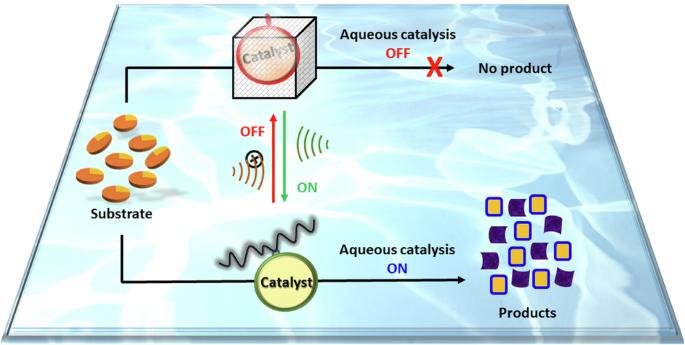机械力开关式水性有机催化反应
IF 9.6
Q1 MATERIALS SCIENCE, MULTIDISCIPLINARY
引用次数: 0
摘要
控制人工催化系统在水介质中的催化活性是生物仿生人工催化剂的重要研究课题。催化系统的活性可通过在催化系统结构中引入刺激响应特性来控制。不过,目前主要使用温度、pH 值或光作为刺激。利用机械力就能 "开/关 "催化活性的水性催化系统尚未得到证实。在这里,我们展示了如何通过使用/停止超声波刺激来 "开/关 "水性催化系统的催化活性。我们证明,催化剂分子咪唑的可及性可通过超声刺激的存在/消失进行调节,从而对水性缓冲溶液中酯水解反应的速率进行时间控制。这种通用方法可以使用大量有机催化剂在水介质中制备分子和/或材料,并将其应用于材料科学和生物医学领域。控制人工有机催化剂系统在水介质中的活性具有挑战性。在此,可以利用超声波刺激打开或关闭水催化系统的有机催化活性,以进行酯水解反应。本文章由计算机程序翻译,如有差异,请以英文原文为准。

Mechanical force-switchable aqueous organocatalysis
Control over the catalytic activity of artificial catalytic systems in aqueous media is of high interest for biomimetic artificial catalysts. The activity of catalytic systems can be controlled via introducing stimuli-responsive feature in the structure of the catalytic systems. However, temperature, pH or light have been predominantly used as stimulus. Aqueous catalytic system whose activity can be turned ‘ON/OFF’ employing mechanical force has not been demonstrated. Here we show how catalytic activity of an aqueous catalytic system can be switched ‘ON/OFF’ via the application/ceasing ultrasound stimulus. We demonstrate that the accessibility of imidazole, a catalyst moiety, can be modulated via the presence/absence of the ultrasound stimulus, resulting temporal control over the rate of ester hydrolysis reactions in aqueous buffer solution. This generic approach enables using a large range of organocatalysts for the preparation of molecules and/or materials in aqueous media for their application to material science, and in biomedical field. It is challenging to control the activity of artificial organocatalyst systems in aqueous media. Here, the organocatalytic activity of an aqueous catalytic system can be turned on or off for ester hydrolysis reactions using ultrasound stimulus.
求助全文
通过发布文献求助,成功后即可免费获取论文全文。
去求助
来源期刊

Communications Materials
MATERIALS SCIENCE, MULTIDISCIPLINARY-
CiteScore
12.10
自引率
1.30%
发文量
85
审稿时长
17 weeks
期刊介绍:
Communications Materials, a selective open access journal within Nature Portfolio, is dedicated to publishing top-tier research, reviews, and commentary across all facets of materials science. The journal showcases significant advancements in specialized research areas, encompassing both fundamental and applied studies. Serving as an open access option for materials sciences, Communications Materials applies less stringent criteria for impact and significance compared to Nature-branded journals, including Nature Communications.
 求助内容:
求助内容: 应助结果提醒方式:
应助结果提醒方式:


